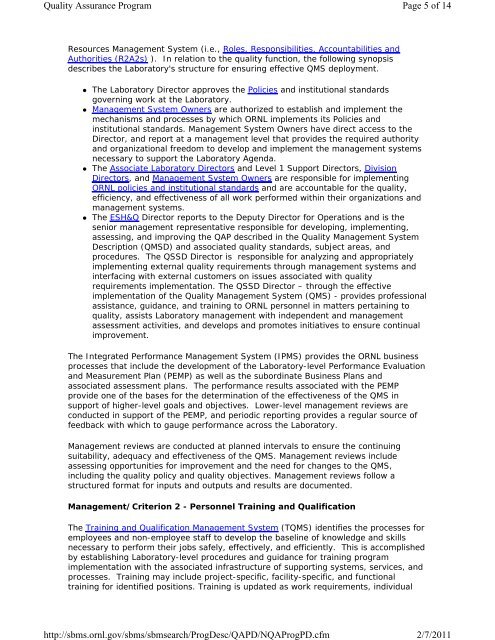Quality Assurance Program - Oak Ridge National Laboratory
Quality Assurance Program - Oak Ridge National Laboratory
Quality Assurance Program - Oak Ridge National Laboratory
You also want an ePaper? Increase the reach of your titles
YUMPU automatically turns print PDFs into web optimized ePapers that Google loves.
<strong>Quality</strong> <strong>Assurance</strong> <strong>Program</strong><br />
http://sbms.ornl.gov/sbms/sbmsearch/ProgDesc/QAPD/NQAProgPD.cfm<br />
Page 5 of 14<br />
2/7/2011<br />
Resources Management System (i.e., Roles, Responsibilities, Accountabilities and<br />
Authorities (R2A2s) ). In relation to the quality function, the following synopsis<br />
describes the <strong>Laboratory</strong>'s structure for ensuring effective QMS deployment.<br />
• The <strong>Laboratory</strong> Director approves the Policies and institutional standards<br />
governing work at the <strong>Laboratory</strong>.<br />
• Management System Owners are authorized to establish and implement the<br />
mechanisms and processes by which ORNL implements its Policies and<br />
institutional standards. Management System Owners have direct access to the<br />
Director, and report at a management level that provides the required authority<br />
and organizational freedom to develop and implement the management systems<br />
necessary to support the <strong>Laboratory</strong> Agenda.<br />
• The Associate <strong>Laboratory</strong> Directors and Level 1 Support Directors, Division<br />
Directors, and Management System Owners are responsible for implementing<br />
ORNL policies and institutional standards and are accountable for the quality,<br />
efficiency, and effectiveness of all work performed within their organizations and<br />
management systems.<br />
• The ESH&Q Director reports to the Deputy Director for Operations and is the<br />
senior management representative responsible for developing, implementing,<br />
assessing, and improving the QAP described in the <strong>Quality</strong> Management System<br />
Description (QMSD) and associated quality standards, subject areas, and<br />
procedures. The QSSD Director is responsible for analyzing and appropriately<br />
implementing external quality requirements through management systems and<br />
interfacing with external customers on issues associated with quality<br />
requirements implementation. The QSSD Director – through the effective<br />
implementation of the <strong>Quality</strong> Management System (QMS) - provides professional<br />
assistance, guidance, and training to ORNL personnel in matters pertaining to<br />
quality, assists <strong>Laboratory</strong> management with independent and management<br />
assessment activities, and develops and promotes initiatives to ensure continual<br />
improvement.<br />
The Integrated Performance Management System (IPMS) provides the ORNL business<br />
processes that include the development of the <strong>Laboratory</strong>-level Performance Evaluation<br />
and Measurement Plan (PEMP) as well as the subordinate Business Plans and<br />
associated assessment plans. The performance results associated with the PEMP<br />
provide one of the bases for the determination of the effectiveness of the QMS in<br />
support of higher-level goals and objectives. Lower-level management reviews are<br />
conducted in support of the PEMP, and periodic reporting provides a regular source of<br />
feedback with which to gauge performance across the <strong>Laboratory</strong>.<br />
Management reviews are conducted at planned intervals to ensure the continuing<br />
suitability, adequacy and effectiveness of the QMS. Management reviews include<br />
assessing opportunities for improvement and the need for changes to the QMS,<br />
including the quality policy and quality objectives. Management reviews follow a<br />
structured format for inputs and outputs and results are documented.<br />
Management/Criterion 2 - Personnel Training and Qualification<br />
The Training and Qualification Management System (TQMS) identifies the processes for<br />
employees and non-employee staff to develop the baseline of knowledge and skills<br />
necessary to perform their jobs safely, effectively, and efficiently. This is accomplished<br />
by establishing <strong>Laboratory</strong>-level procedures and guidance for training program<br />
implementation with the associated infrastructure of supporting systems, services, and<br />
processes. Training may include project-specific, facility-specific, and functional<br />
training for identified positions. Training is updated as work requirements, individual

















